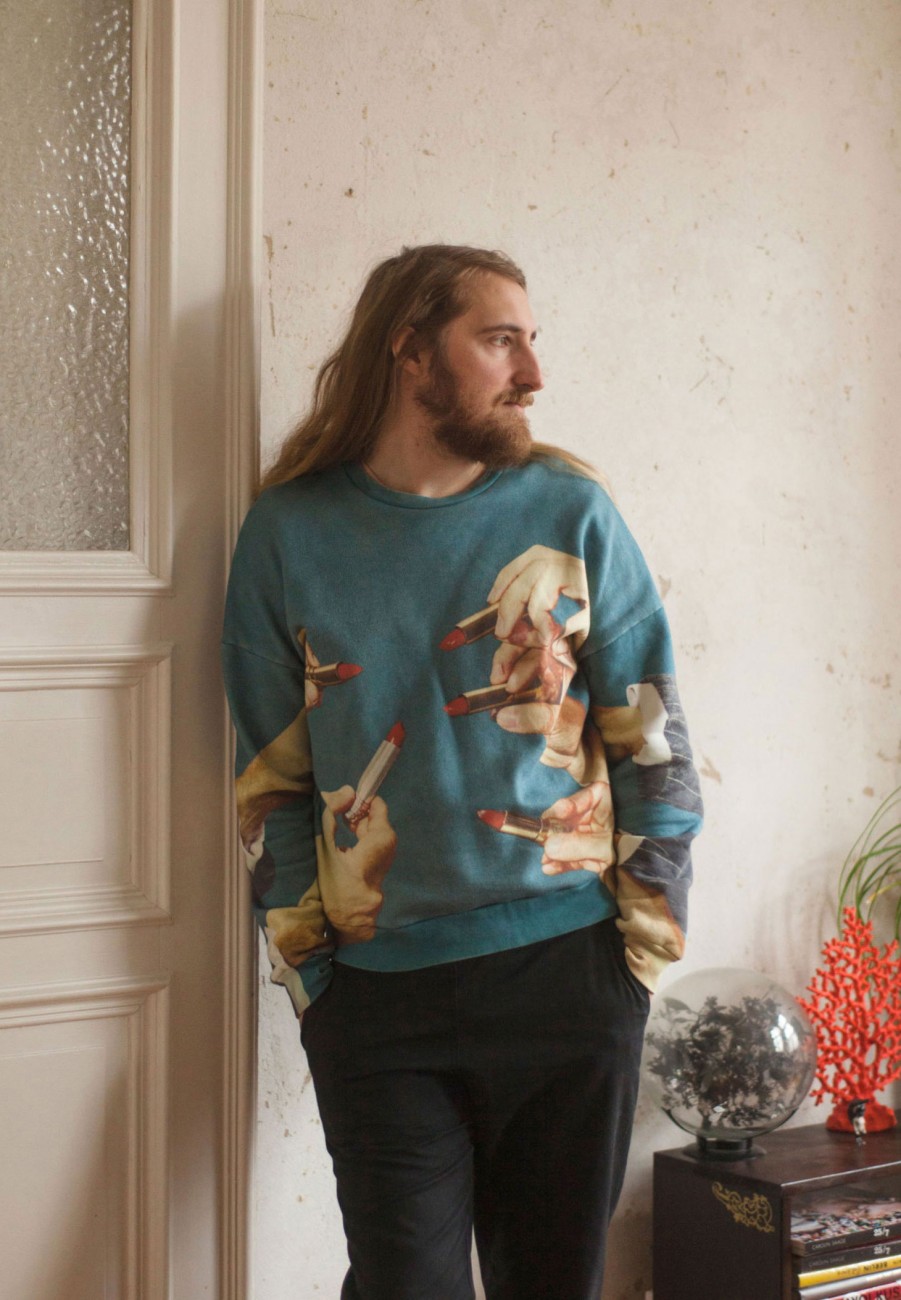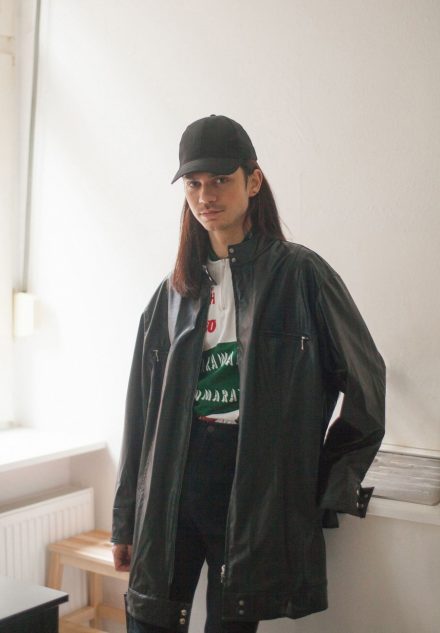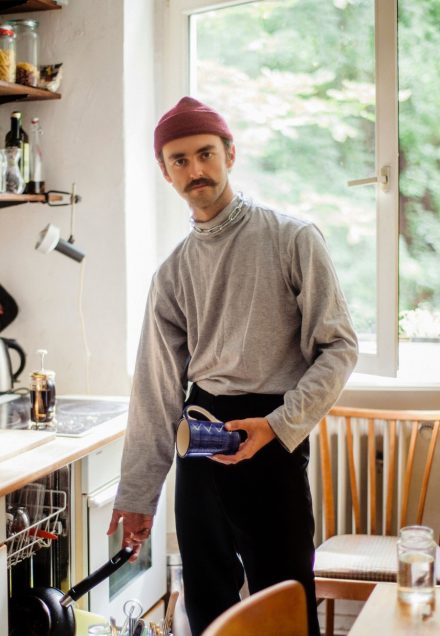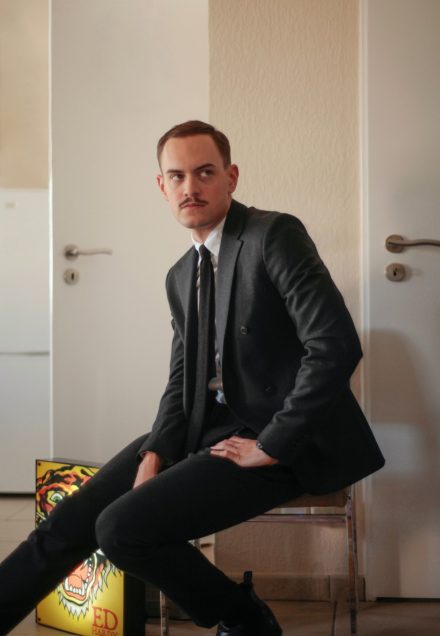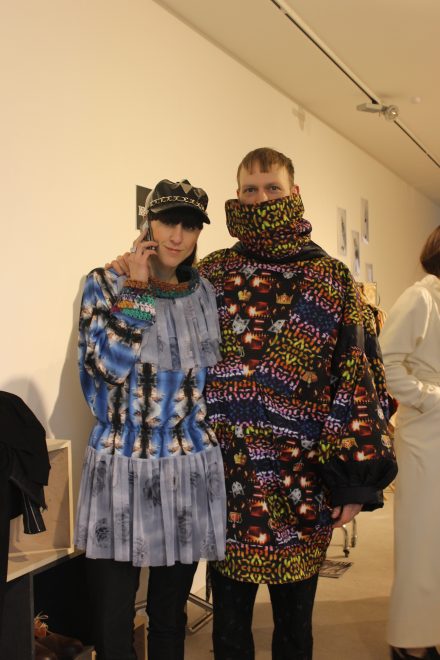When it comes to Berlin, this man is an expert in all things life-style and culture… Frank R. Schröder is the founder of the cult blog iHeartBerlin and a precious witness of what’s been going down on the fellow side of fashion. With these premises, leaving out his experience and knowledge about man’s relationship with personal style was never an option!

ΠMagazine: Do clothes matter to you?
Frank: Yes, they do. I’m not obsessed with fashion or spend all my time with it but it definitely matters! For example I appreciate good design and enjoy seeing how a label sets up an inspiring collection. I also like when fashion is funny. Not in a costumy way but when you can tell that the designer has a sense of humor.
ΠMagazine: Can you remember the first time you were conscious about fashion?
Frank: Mmm it’s hard to pin that back. When I was a teenager my parents moved to a house outside the city so I was living in this village where my sourcing of fashion was the Neckermann catalogue! (laughs). I think I was still somewhat fashionable in school. Now of course whenever I see pictures I’m thinking Oh my god! However, when I moved to Berlin at the age of 18, embracing fashion became easier. I‘m a little embarrassed to admit it now, but I remember quite clearly having a crush on Diesel and being fascinated by their campaigns and storytelling. Over the years of course the label became less interesting to me, but that was the first time I was a fan of something in that way. Anyway, the more fashionable chapter of my life really started with iHeartBerlin back in 2007. At first the blog had little to do with design and trends but pretty soon I was invited to fashion shows and events and that’s how I actually got exposed to the Berlin scene. We started writing about them, season after season and I guess that’s how I became a more fashion aware person.
Œ Magazine: How dramatically did your style change throughout this “process”?
Frank: That I’m aware of, not so dramatically. Of course up to that moment my style had been more random. A lot of H&M and other ordinary brands. In Berlin I started seeing the more individualistic things on the market, liking garments with a story that you don’t see a million times on the streets. I was suddenly attracted by things that were hard to get a hold of, by there uniqueness. It’s great to own something you look completely different in and stresses a special aspect of you personality.
ΠMagazine: Why is looking unique a big deal? What does that mean to you?
Frank: I just know, I never had the urge to do something to be part of a group. You know, I didn’t start smoking to hang out with the cool kids in school and I wouldn’t buy something just to build a particular style. Okay, maybe once I did, but I failed… That was 2014 and I was in New York. Sportswear avant-garde was getting big and I walked by this small shop in Nolita that had an interesting take on something that I actually thought boring, so I decided to check it out. You have to know that I’m a very emotional shopper. In fact, I couldn’t find the piece I wanted in my size, so I bought something else just because I was there, only to end up feeling silly and never wearing it. I looked like a Berghain kid… which I’m clearly not (laughs).
ΠMagazine: So you were bothered by the association of the piece?
Frank: Yes. It didn’t feel like me. That’s why I deliberately ignore most trends.
Œ Magazine: Would you agree that NOT wanting to be part of group is as much of a statement as wanting to be part of one? Sometimes it feels like having a unique style is becoming a trend in itself. Everyone is very concerned with standing out and it’s bizarre and contradictory that what looked personal and exotic a couple of years back and set out to be unique, is now considered mainstream.
Frank: Oh yes. The mix and match trend for example was a lot better once and, honestly, people have never looked more generic to me. I think it has something to do with the availability of fashion through Instagram and blogs. Trends are available worldwide within seconds and people can easily appropriate and copy them and all end up looking the same. This wasn’t that case ten years ago, when I first got involved with fashion. There were way more individual looking people back then.
ΠMagazine: Can you recall a trend of that time you refused to participate in?
Frank: I’m not sure. But for instance: a few years back this one look became very common in Berlin, especially in Neukölln. I’m talking about the beanie-head plus big overcoat plus skinny black jeans. It was – and kind of still is – everywhere and I just couldn’t identify with it. Now you look at people who go to Berghain and they all look the same as well. Obviously, everyone is wearing a slightly different vintage transparent top, but there is still a clear dress code.
Œ Magazine: That’s true and yet, a growing number of people who have little to do with the techno scene and subculture are dressed in the same uniform.
Frank: Yes and what’s a subculture if you can just decide to be a part of it by dressing in a certain way, almost as if you were grocery shopping?
ΠMagazine: Right! It reminds me of gentrification, only related to fashion.
Frank: Although, to be fair, you can still sense when someone is putting a look on as a costume or trying to identify as something they are not. It’s so funny. At first the people we like to refer to as hipsters kind of looked outrageous: they wore these colorful outlandish clothes and combinations and looked a bit kooky. I was thinking WOW, these people are really courageous to break the norm and wear such crazy things. They didn’t have Pinterest and blogs so what they chose to wear in order to look different never ended up matching or looking dull because they didn’t have a comparison the same way we do today. It’s through these individuals that the more interesting trends evolved.
ΠMagazine: What do you think inspired and influenced this first generation of hipsters?
Frank: Everyday life! Common things they came across. I mean, vintage and second hand shops were already happening, but it probably took a little more out-of-the-box thinking to go and buy something there or to borrow a coat from grandma… Then I suppose traveling to places and finding treasures, things that would feel eccentric back home, was easier. The big brands were more localized so you could simply go to Topshop in London and then come back here and look different. Now everything is globalized, which is not necessarily a bad thing, but makes it a bit frustrating.
Œ Magazine: How are you putting up with this “issue”?
Frank: I feel like I have two looks or categories of clothes. There are the normal, ordinary clothes and the crazier ones I collected over the years or found on the Internet. I mostly shop online because that’s where I still react to things and feel surprised!
ΠMagazine: So despite what we were saying before you still experience that aha moment every now and then when shopping?
Frank: Yes!
Œ Magazine: The first category of clothes you mentioned, the ordinary ones— how exactly are they ordinary? What does that mean to you?
Frank: To me ordinary is something like this t-shirt. The only thing you probably won’t see on me are normal socks. I have an obsession with ridiculous socks. Sometimes I try to match the colors but if not, whatever. But I also have other louder pieces with somewhat extravagant prints or patterns.
ΠMagazine: Based on what criteria do you pick an ordinary outfit as opposed to a sophisticated crazy print one? Does the occasion play into the thought process?
Frank: I think it all comes down to my mood. The occasion doesn’t matter at all.
ΠMagazine: Is there anything else that describes your relationship with fashion?
Frank: I’m attracted by pieces with a story or that have something personal to them. That’s why I like small designers. I own a lot of pieces designed by people I’m friends with or I met personally over the years. I’m friends with Julia Heuse. She had label for a long time and we became friends through iHeartBerlin. She once made a fabulous custom trench coat for me. We chose the fabric together and everything and people are very impressed by it whenever I wear it. I’m also a big fan of designers like Bernard Wilhelm and Henrik Vibskov because of their experimental graphic style. Their pieces are colorful and happy and I guess making someone smile with a freaky sweater is worth much more then impressing someone with a fancy couture dress.
ΠMagazine: I agree, humor is so healthy and taking fashion too seriously can be very unattractive! Do you ever talk about fashion with your friends?
Frank: I have few fashion fanatic friends but I talk about it with my husband since he is also the one I go shopping with. I like his style. He’s the type of guy that takes a long time to put together and think through an outfit, while I just throw on something. He is also the opposite style-wise; he has a more sophisticated toned look, which I appreciate.
ΠMagazine: As an observer of lifestyle and people, what can you tell me about men and fashion in Berlin? Did you notice any specific development in the past years?
Frank: The guys here have a good sense of fashion compared to other cities or countries. In Argentina, where I’ve spent a lot of time in the last 5 years, male fashion is very small. I could rarely buy cool stuff there. I struggle to find things in my size but also things that correspond to my taste. Plus there is just not a lot of cool stuff – unlike here. Actually I feel like we are quite privileged in Berlin to have all these options. From where I stand, men’s style is very sportswear dominated but there is also a tiny dandy scene made of shirts, nice jackets and stuff. People seem to appreciate a casual sexy look more then a sophisticated one and I feel pretty aligned with that. Of course guys are still very shy about expressing themselves with clothes.

ΠMagazine: Do you think straight guys have as much fun with fashion as gay ones?
Frank: It’s definitely gotten better. There are still more gay men with a natural outspoken sense of fashion than straight men with these characteristics. But then again, it’s so blurred. Everyone is a bit queer in Berlin and it’s becoming hard to make the distinctions.
Œ Magazine: I know what you mean! The New York Times published this exhilarating article a couple of weeks back “Hipsters broke my gaydar” —genius!
Frank: I read that too! And, you know, given that the lifestyle of a gay person is, by means of society, a little alternative already, there is less pressure on having to look a certain way whereas straight guys subconsciously still suffer the expectation of virility. Lucky for them, gays have been breaking the ice for all men and by getting so much recognition fashion wise they encouraged dudes of all kinds to have more fun with it. Instagram and the availability of fashion and trends on social media also had a role in this. When you scroll through the feed of these platforms you don’t always know if an influencer is gay or not. That way a greater acceptance for extravagant styles has slowly been spreading.
Œ Magazine: Enlightening! So you believe there is hope for straight men’s fashion taste?
Frank: Oh absolutely! Which is also great for the girls because they finally get to skip the part at the beginning of a relationship where the give the man a makeover and pimp his wardrobe!
ΠMagazine: (laughs) And we like this broadcast very much!
